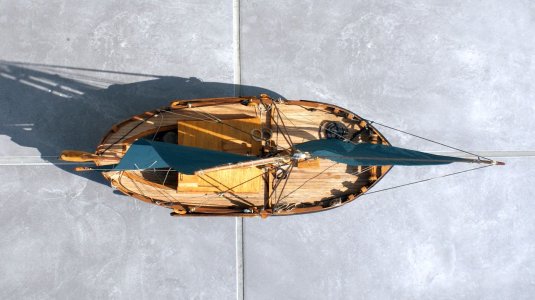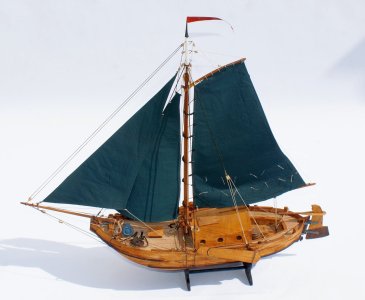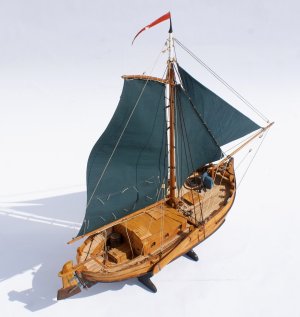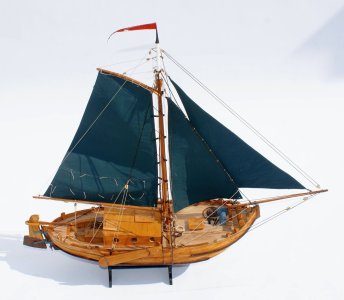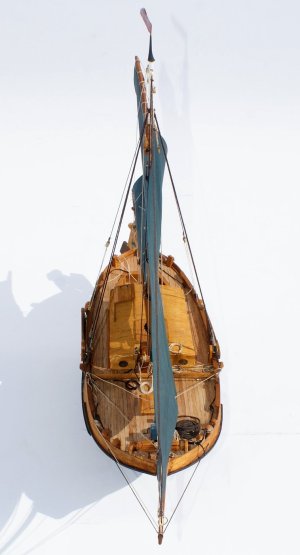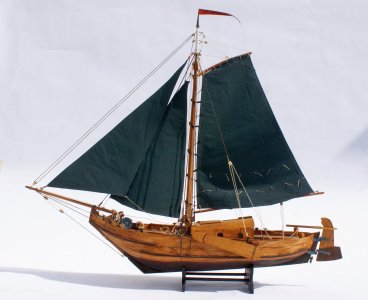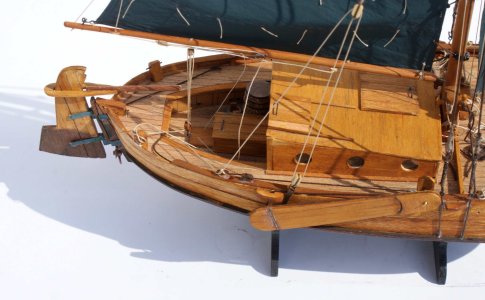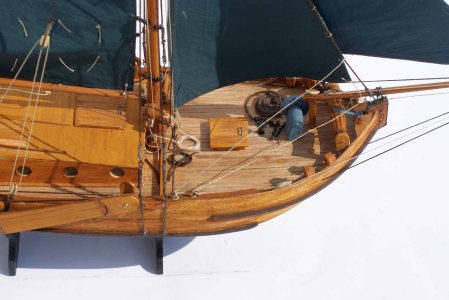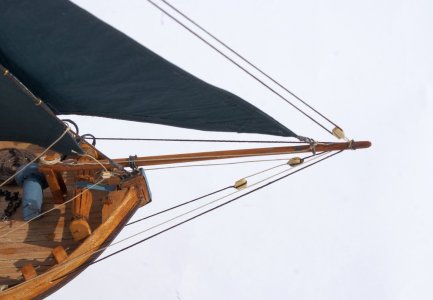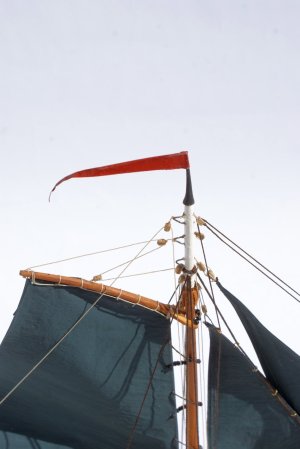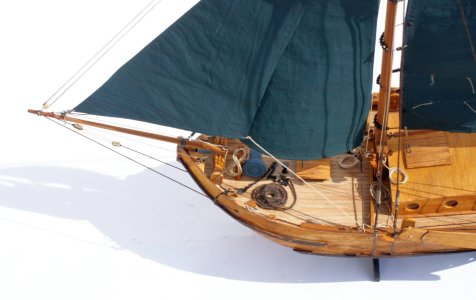Hengst JAN KORNEEL, Scratch build, 1:36 scale (Completed)
At the same time as another project, I started to prepare a fishing boat with side boards and origin in the Netherlands; like the ones I have undertaken, I prefer to develop medium or small sized vessels, that are unique, or that have history; that allow me to do some research, but more than anything that are not very complex, because I know my limitations.
History
This boat is called “Hengst”, they are small in size as they do not reach 12 meters in length, they have 10 tons of displacement and although from a distance they may seem similar to others, the Hengst type are differentiated by their bow, the small cabin and that their hull is made up of few and wide planks.
The first photos show the original Hengst, the first one taken at the beginning of the last century and the second one seems to have been taken in the 60's. The Hengst Jan Korneel has had several registrations TH5, CLN15, CH5, in the 80's it was converted into a pleasure sailboat and it seems that recently, the boat has been modified again to its original characteristics. In an article published by the DDR magazine, Modellbau Heute (November and December 1988), there are the general plans that I show in the following photos and that have served as a basis for this project. The article written by Christoph Geyer is extensive, descriptive, I have freely translated it and some paragraphs are transcribed below:
A Hengst from Zeeuwse on the Mueggelzee
by Christoph Geyer
“During the festivities for the 750th anniversary of Berlin in 1987, a colourful parade of ships and boats took place in July; culminating in a group of traditional sailing ships. Of the classics announced for the Netherlands, only two turned up. But the next day, when no one expected it, on the morning of 27 July 1987, a larger group of Tjalken, Aaken and other ships sailed over the Jannowitz Bridge in the direction of Köpenick. Alerted, two members of the GDR working group for aviation and naval history, Michael Sohn and Christoph Geyer, went with their photographic equipment in the direction of the Spindlersfeld Bridge. The assumptions turned out to be correct, because the ships were moored at Spindlersfeld and the forest of masts could already be seen from the Spree Bridge. A rowboat was rented and as we approached, the most striking thing was how colourful these boats were, just like the original ones.”
“There, next to the larger ships, a small one stood out for its unique beauty. It was the only one with a wooden hull. This is a Zeeland fishing boat, a Hengst (in the Zeeuwse dialect Hengst-holl), built in 1908, with a displacement of about 10 tons. There are only four boats of this type, so we accepted the invitation to board, culminating with a cruise on the Müggelsee.”
“The Hengst Jan Korneel is a straight-bowed fishing boat widely used in the Westerschelde area (Netherlands) and was still in operation 20 years ago. At first glance, the ship resembles a Hoogaar (see Modellbau Heute 6'83), whose origins are difficult to establish. In an Antwerp painting from 1515, a precursor ship of the Hengst can be seen; the oldest known written mention of the Hengst dates from 1711. However, illustrations of technical details are rare. Virtually all Hengsts were built in the Westerschelde shipyards in Zeeland, usually without plans or tools. Only the main measurements and their general characteristics were the necessary prerequisites. In some literature, the Hengst is described as a ship similar to the Hoogaars – that is a mistake. These two types of boats are similar in their flat bottom and the type of outer hull construction, but their layout, frame shape, planking type, rudder shape and characteristic silhouette distinguish the Hengst from the Hoogaars. The flat bottom is evenly curved in a teardrop shape with the rounded side towards the bow. The Hengst has a flare at the bow which creates enough space for the wide gunwale. The side line, which connects the bow to the chest, has a deep arch near the bow, making the Hengst’s bow appear taller and more robust than the elegantly stretched Hoogaars.”
“One more thing about the daggerboards. Dutch and Zealand waters are characterised by frequent, narrow and current-ridden shoals, the influence of tides and a high traffic density. This results in the highest demands on the manoeuvrability of the ships. The daggerboard is tailored to these requirements, it has a wing-shaped profile, which has a great effect even at low immersion depths. When tacking, care must be taken that the leeward daggerboard drops while the ship is righting itself. If the daggerboard rig is lowered too early, the daggerboard will not submerge. When the ship is abeam, the daggerboard gets stuck in the hull and does not lower; after tacking, the daggerboard floats on the free windward side of the hull and can be picked up effortlessly. Inland waterway ships can be distinguished from sea vessels by the shape of their daggerboards. Unlike the short, wide daggerboards of inland vessels, sea daggerboards are long, narrow, rather paddle-shaped and have a more pronounced profile. Even on larger steel vessels, daggerboards are often made of wood. It is amazing when you see how easily a Skutsje with its 50 tons and 10-meter-long boom turns through the wind. Without hurrying, the helmsman sets the rudder, the daggerboard drops, the mainsheet is lowered and it continues on at full speed.”
Before continuing with the description of the construction of the model, I will continue to investigate this small boat, since its profile, size and rigging are similar to other boats such as Botters, Skokers, Blazers, etc. The difference is that the bow is straight instead of a gentle curve; the other does not have a cabin, and so on. A detail of the many types of boats developed in the Netherlands is shown in the following links.
https://www.ssrp.nl/stamboek/scheepstypes
https://www.ssrp.nl/stamboek/scheepstypes/zeeuwse-schepen/hengst
References


 www.facebook.com
www.facebook.com
 www.ssrp.nl
https://rven.info/register/1233
www.ssrp.nl
https://rven.info/register/1233
https://www.pinterest.com/pin/hengst-th-5-jan-korneel--550002173221014921/
Building the model
The fifth photo is a screenshot of the drawing I made in Autocad 18 ®, where I draw several layers on the plane (false keel, frames, deck, special parts) and give them a scale (in this case I used 1:36). I order the parts and make a PDF printout, which I will use to send to the bookstore and have them laser cut on 4 mm plywood sheets and the other 1.2 mm thick ones.
The frames were aligned and mounted on the false keel. As you can see, the outer side of the frames is made up of straight segments, since the outer hull of the original boat is built with wide planks (7 on each side). So in this model I will not use 2x5 mm planks, but I will simulate the planks using variable width planks of 1 mm that will go from bow to stern, cut to the appropriate shape so that when folded they fit the frames and fit together. I will have to make cardboard molds of each plank and adjust their shape and size. Well, I hope that procedure works
I made a mock hull out of cardboard and obtained the templates for the 7 wide strakes that make up the half hull. The strakes were cut from 1 x 50 x 800 mm wooden planks, the bottom strake was easy as it was flat, but the second strake was the problem, they didn't fit and there were gaps or the strake had to be twisted in its plane, I think you would have to give at least 3 mm on each side of each strake to adjust it when it is being assembled. I discarded that method and obtained each strake by measuring on the frames. I think that, for a similar future project, I could draw the hull in ACAD 3D and then extend the obtained surfaces on a plane.
Once the wide strakes were fixed, the hull was sanded very carefully to eliminate protrusions and gaps between the strakes. It was sealed with a mixture of putty, shavings and white rubber, filling the joints and deficiencies of the hull; It was sanded using 100, 150 and 320 grit sandpaper. After checking that there were no gaps and that the fillers were not noticeable, it was decided that the boat would have a “well-worked” appearance (like the one in photo 2 of the first part), so the hull was stained walnut and the topsides in a well-diluted honey color, and scrapes were made to give the appearance of use or wear.
0.5 mm thick veneer was cut to simulate the deck planking, the straight slats would be 4 mm wide, the edges were blackened with charcoal and glued with white rubber. Afterwards it was sanded with 250 grit sandpaper and an aging effect was simulated with Judea bitumen. The deck was taken and mounted on the hull. The bowsprit, mainmast, boom and gaff were cut from cedar wood, and the corresponding conicity was given using a brush and coarse and fine sandpaper; some holes were drilled and it was stained in a honey tone. Then the bow and stern bitts and the rails were placed in the same tone as the topsides. The cabin, the entrance to the hold, and the rudder, which has a very special shape and size, were installed. The other deck elements, the masts and the bowsprit were also installed.
From the C. Geyer plan, the dimensions of the sails were taken, which were transferred to a paper that will be used as a mold for cutting the sail, whether it is paper or cloth. For this project I will choose dark olive green paper sails, or is that what I intende. Tissue paper with two or three coats of acrylic paint is used, a reinforcing thread is passed through and the edges are folded. The mainsail is mounted on its respective peak and boom, also tying the blocks and ropes. We use a thick “raw” colored cotton thread for the running rigging. For the fixing elements such as stays and shrouds, thicker cotton threads will be used, darkened and hardened with Judean bitumen. As complementary deck elements, an anchor and its rope will be placed. At the top of the masts a purple pennant.
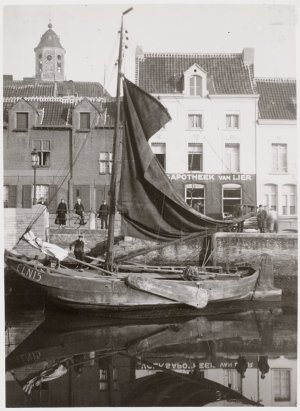
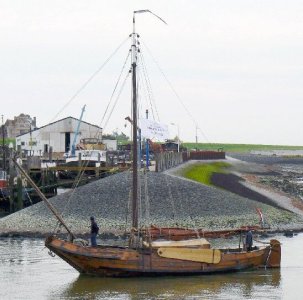

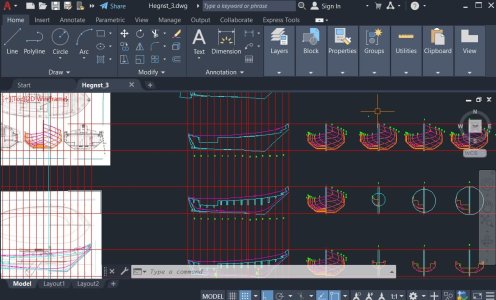
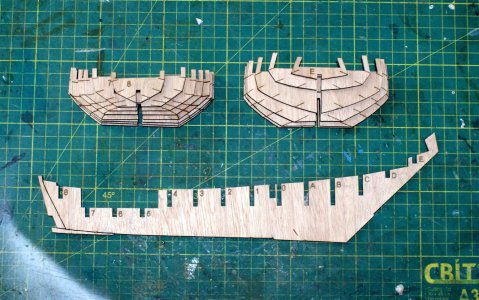
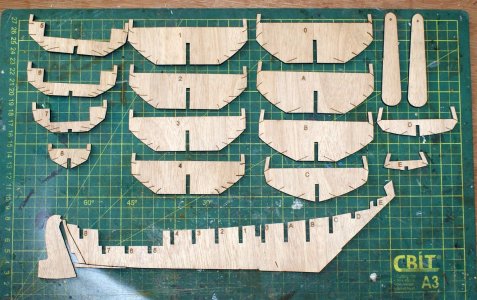

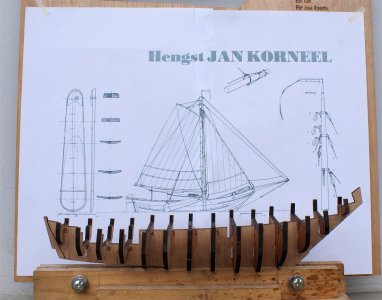
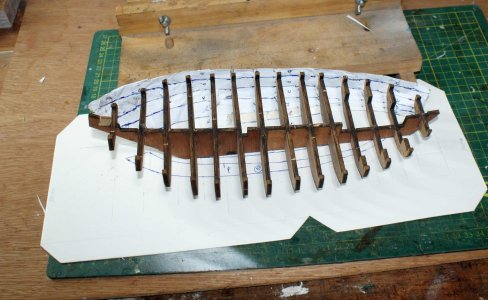
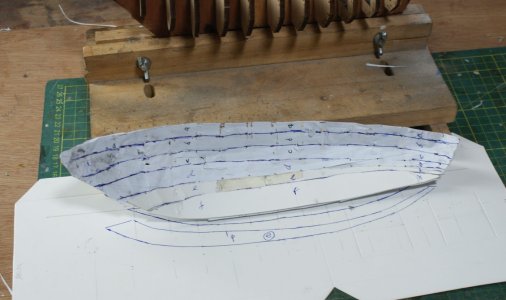
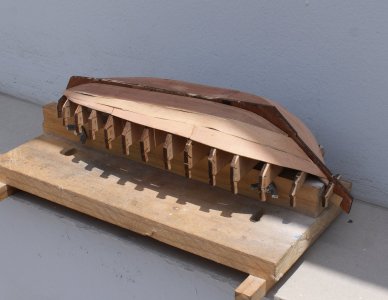

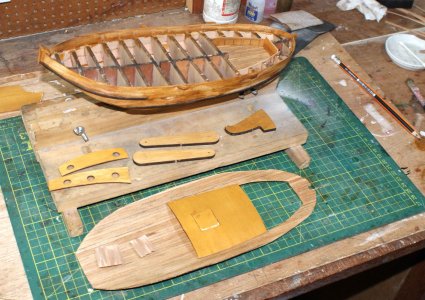
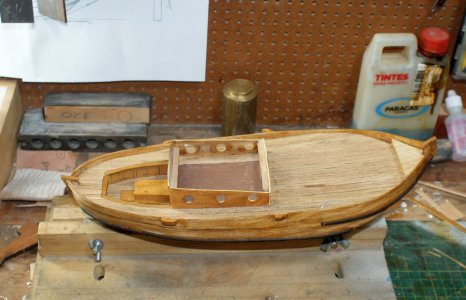
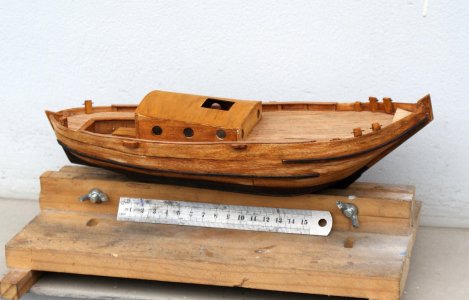
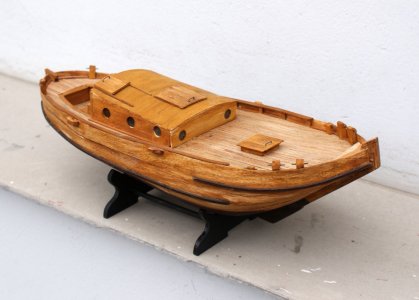

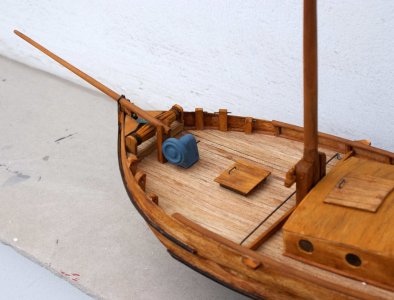


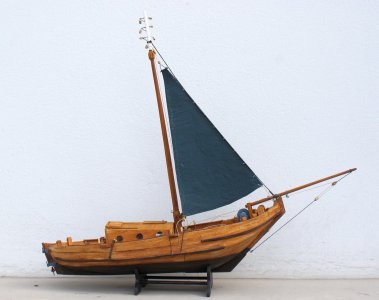

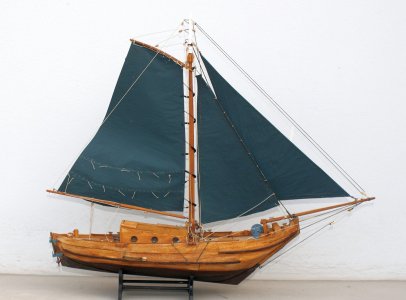
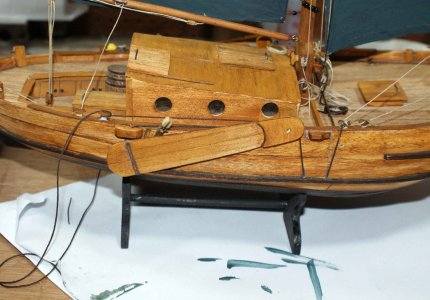
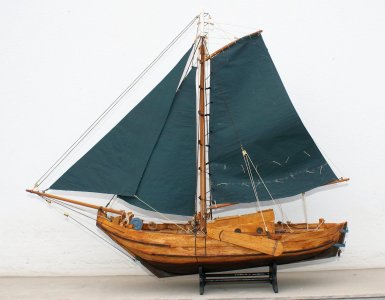
At the same time as another project, I started to prepare a fishing boat with side boards and origin in the Netherlands; like the ones I have undertaken, I prefer to develop medium or small sized vessels, that are unique, or that have history; that allow me to do some research, but more than anything that are not very complex, because I know my limitations.
History
This boat is called “Hengst”, they are small in size as they do not reach 12 meters in length, they have 10 tons of displacement and although from a distance they may seem similar to others, the Hengst type are differentiated by their bow, the small cabin and that their hull is made up of few and wide planks.
The first photos show the original Hengst, the first one taken at the beginning of the last century and the second one seems to have been taken in the 60's. The Hengst Jan Korneel has had several registrations TH5, CLN15, CH5, in the 80's it was converted into a pleasure sailboat and it seems that recently, the boat has been modified again to its original characteristics. In an article published by the DDR magazine, Modellbau Heute (November and December 1988), there are the general plans that I show in the following photos and that have served as a basis for this project. The article written by Christoph Geyer is extensive, descriptive, I have freely translated it and some paragraphs are transcribed below:
A Hengst from Zeeuwse on the Mueggelzee
by Christoph Geyer
“During the festivities for the 750th anniversary of Berlin in 1987, a colourful parade of ships and boats took place in July; culminating in a group of traditional sailing ships. Of the classics announced for the Netherlands, only two turned up. But the next day, when no one expected it, on the morning of 27 July 1987, a larger group of Tjalken, Aaken and other ships sailed over the Jannowitz Bridge in the direction of Köpenick. Alerted, two members of the GDR working group for aviation and naval history, Michael Sohn and Christoph Geyer, went with their photographic equipment in the direction of the Spindlersfeld Bridge. The assumptions turned out to be correct, because the ships were moored at Spindlersfeld and the forest of masts could already be seen from the Spree Bridge. A rowboat was rented and as we approached, the most striking thing was how colourful these boats were, just like the original ones.”
“There, next to the larger ships, a small one stood out for its unique beauty. It was the only one with a wooden hull. This is a Zeeland fishing boat, a Hengst (in the Zeeuwse dialect Hengst-holl), built in 1908, with a displacement of about 10 tons. There are only four boats of this type, so we accepted the invitation to board, culminating with a cruise on the Müggelsee.”
“The Hengst Jan Korneel is a straight-bowed fishing boat widely used in the Westerschelde area (Netherlands) and was still in operation 20 years ago. At first glance, the ship resembles a Hoogaar (see Modellbau Heute 6'83), whose origins are difficult to establish. In an Antwerp painting from 1515, a precursor ship of the Hengst can be seen; the oldest known written mention of the Hengst dates from 1711. However, illustrations of technical details are rare. Virtually all Hengsts were built in the Westerschelde shipyards in Zeeland, usually without plans or tools. Only the main measurements and their general characteristics were the necessary prerequisites. In some literature, the Hengst is described as a ship similar to the Hoogaars – that is a mistake. These two types of boats are similar in their flat bottom and the type of outer hull construction, but their layout, frame shape, planking type, rudder shape and characteristic silhouette distinguish the Hengst from the Hoogaars. The flat bottom is evenly curved in a teardrop shape with the rounded side towards the bow. The Hengst has a flare at the bow which creates enough space for the wide gunwale. The side line, which connects the bow to the chest, has a deep arch near the bow, making the Hengst’s bow appear taller and more robust than the elegantly stretched Hoogaars.”
“One more thing about the daggerboards. Dutch and Zealand waters are characterised by frequent, narrow and current-ridden shoals, the influence of tides and a high traffic density. This results in the highest demands on the manoeuvrability of the ships. The daggerboard is tailored to these requirements, it has a wing-shaped profile, which has a great effect even at low immersion depths. When tacking, care must be taken that the leeward daggerboard drops while the ship is righting itself. If the daggerboard rig is lowered too early, the daggerboard will not submerge. When the ship is abeam, the daggerboard gets stuck in the hull and does not lower; after tacking, the daggerboard floats on the free windward side of the hull and can be picked up effortlessly. Inland waterway ships can be distinguished from sea vessels by the shape of their daggerboards. Unlike the short, wide daggerboards of inland vessels, sea daggerboards are long, narrow, rather paddle-shaped and have a more pronounced profile. Even on larger steel vessels, daggerboards are often made of wood. It is amazing when you see how easily a Skutsje with its 50 tons and 10-meter-long boom turns through the wind. Without hurrying, the helmsman sets the rudder, the daggerboard drops, the mainsheet is lowered and it continues on at full speed.”
Before continuing with the description of the construction of the model, I will continue to investigate this small boat, since its profile, size and rigging are similar to other boats such as Botters, Skokers, Blazers, etc. The difference is that the bow is straight instead of a gentle curve; the other does not have a cabin, and so on. A detail of the many types of boats developed in the Netherlands is shown in the following links.
https://www.ssrp.nl/stamboek/scheepstypes
https://www.ssrp.nl/stamboek/scheepstypes/zeeuwse-schepen/hengst
References

Modellbau Heute 1988-11 : Free Download, Borrow, and Streaming : Internet Archive
Die Modellbau heute, kurz mbh, war eine Monatszeitschrift der GST, die sich mit allen Facetten des Modellbau beschäftigte. Die erste Ausgabe erschien im...
archive.org

Hengst Jan Korneel
Hengst Jan Korneel. 169 likes · 3 talking about this. Personal blog
 www.facebook.com
www.facebook.com
Jan Korneel TH5
Deze hengst werd gebouwd in 1908 te Hontenisse - Zeeuws Vlaanderen - hoogstwaarschijnlijk op de werf van J.F.de Klerk in Kruispolderhaven. Het werfboek van de Klerk vermeldt een "Nieuwen Hingst van...
https://www.pinterest.com/pin/hengst-th-5-jan-korneel--550002173221014921/
Building the model
The fifth photo is a screenshot of the drawing I made in Autocad 18 ®, where I draw several layers on the plane (false keel, frames, deck, special parts) and give them a scale (in this case I used 1:36). I order the parts and make a PDF printout, which I will use to send to the bookstore and have them laser cut on 4 mm plywood sheets and the other 1.2 mm thick ones.
The frames were aligned and mounted on the false keel. As you can see, the outer side of the frames is made up of straight segments, since the outer hull of the original boat is built with wide planks (7 on each side). So in this model I will not use 2x5 mm planks, but I will simulate the planks using variable width planks of 1 mm that will go from bow to stern, cut to the appropriate shape so that when folded they fit the frames and fit together. I will have to make cardboard molds of each plank and adjust their shape and size. Well, I hope that procedure works
I made a mock hull out of cardboard and obtained the templates for the 7 wide strakes that make up the half hull. The strakes were cut from 1 x 50 x 800 mm wooden planks, the bottom strake was easy as it was flat, but the second strake was the problem, they didn't fit and there were gaps or the strake had to be twisted in its plane, I think you would have to give at least 3 mm on each side of each strake to adjust it when it is being assembled. I discarded that method and obtained each strake by measuring on the frames. I think that, for a similar future project, I could draw the hull in ACAD 3D and then extend the obtained surfaces on a plane.
Once the wide strakes were fixed, the hull was sanded very carefully to eliminate protrusions and gaps between the strakes. It was sealed with a mixture of putty, shavings and white rubber, filling the joints and deficiencies of the hull; It was sanded using 100, 150 and 320 grit sandpaper. After checking that there were no gaps and that the fillers were not noticeable, it was decided that the boat would have a “well-worked” appearance (like the one in photo 2 of the first part), so the hull was stained walnut and the topsides in a well-diluted honey color, and scrapes were made to give the appearance of use or wear.
0.5 mm thick veneer was cut to simulate the deck planking, the straight slats would be 4 mm wide, the edges were blackened with charcoal and glued with white rubber. Afterwards it was sanded with 250 grit sandpaper and an aging effect was simulated with Judea bitumen. The deck was taken and mounted on the hull. The bowsprit, mainmast, boom and gaff were cut from cedar wood, and the corresponding conicity was given using a brush and coarse and fine sandpaper; some holes were drilled and it was stained in a honey tone. Then the bow and stern bitts and the rails were placed in the same tone as the topsides. The cabin, the entrance to the hold, and the rudder, which has a very special shape and size, were installed. The other deck elements, the masts and the bowsprit were also installed.
From the C. Geyer plan, the dimensions of the sails were taken, which were transferred to a paper that will be used as a mold for cutting the sail, whether it is paper or cloth. For this project I will choose dark olive green paper sails, or is that what I intende. Tissue paper with two or three coats of acrylic paint is used, a reinforcing thread is passed through and the edges are folded. The mainsail is mounted on its respective peak and boom, also tying the blocks and ropes. We use a thick “raw” colored cotton thread for the running rigging. For the fixing elements such as stays and shrouds, thicker cotton threads will be used, darkened and hardened with Judean bitumen. As complementary deck elements, an anchor and its rope will be placed. At the top of the masts a purple pennant.



























